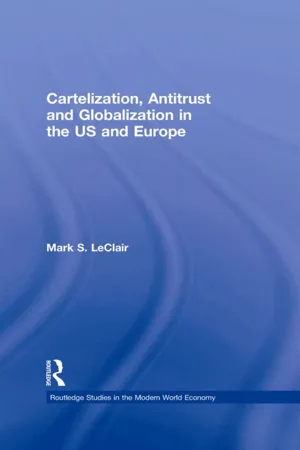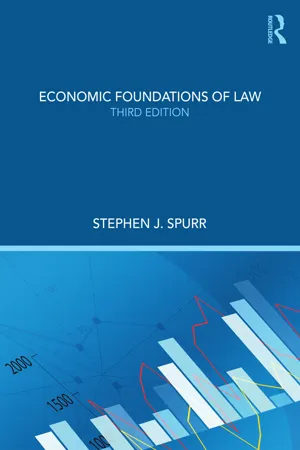Cartel Pricing
Cartel pricing refers to the practice where a group of competing firms in an industry collude to set prices at a higher level than would exist in a competitive market. By coordinating their pricing strategies, cartel members can restrict output and maximize their collective profits. This behavior is typically illegal and can lead to antitrust investigations and legal actions.
4 Key excerpts on "Cartel Pricing"
- Mark S. LeClair(Author)
- 2012(Publication Date)
- Routledge(Publisher)
...Since competition on price is destructive, each firm will eventually settle into a pricing pattern that closely mirrors its competition. This cooperate outcome is neither unanticipated, nor illegal. The collusive outcome: the basics When a market is cartelized, a variety of pricing strategies can be adopted to maximize the profits of the industry as a whole. Utilizing the variables from Cournot–Nash (see above), profit-maximization by the cartel would imply: Price is set by the combined output of the two firms and the overall outcome is equivalent to a monopolist possessing two centers of production. The two first-order conditions are: and: Since the first two terms in (9) and (10) are identical, the result implies that the marginal cost for the first producer must equal that of the second producer. If both firms have identical cost functions, the outputs will be equal. Otherwise, the producer with the lowest costs will realize a greater proportion of the combine cartel output. Although equations (9) and (10) represent the “ideal” outcome under a cartel (understanding that except for the two participants of the duopoly, the non-competitive outcome is far from ideal), collusive agreements in the real world only approximate the result described above. As noted in Chapter 5, many of the pricing and output decisions in cartel arrangements formed since 1990 were reduced to simple agreements that the firms stay off of one another’s turf. The international commodity cartels that were prevalent in the developing world under UNCTAD involved complex agreements and compromises on production and exports. It is difficult to imagine either process resulting in a collusive ideal. Thus the theoretical outcome outlined above should be regarded as a tendency of a cartel rather than a true description of cartel behavior. Antitrust policy and firm behavior The analysis presented above does not include the potential fines that may arise from antitrust action taken against cartel members...
- eBook - ePub
- Stephen J. Spurr(Author)
- 2019(Publication Date)
- Routledge(Publisher)
...The members of a cartel may be buyers or sellers. In a cartel of sellers, the firms may agree to charge a price above the competitive price, or to restrict output below the competitive level of output. A cartel may also divide a market among its members, so that each member has a monopoly of the share of the market assigned to it. The market might be divided geographically, or along product lines, or by groups of customers. In 1897 E. I. du Pont de Nemours & Co. and several other American firms engaged in the manufacture of explosives entered into an agreement with a group of European companies that explicitly assigned most of the countries in the western hemisphere to the American firms, and other parts of the world to the European firms. A division of the market can also be made along product lines: if there are only two firms providing telephone service in a country, they might agree that one firm will acquire a monopoly of long-distance telephone service while the other takes local telephone service. Finally, a cartel can agree to divide customers among its members; in one case several laundries agreed that each laundry would keep its current customers, and would not attempt to attract customers away from the other laundries. 2 Figure 2.4 A cartel. Let us consider a cartel of sellers that agrees either to charge a price above the competitive price or to restrict total output. In Figure 2.4, a competitive industry would produce output of Q c at a price P c. If all the firms in this industry banded together to form a cartel, they might agree to restrict their total output to Q m, or might agree that each firm would charge a price of P m. In either case the result is the same, assuming all firms in the cartel abide by the agreement: the cartel will operate at point B on the market demand curve. Game theory and the prisoners’ dilemma In the cases of both pure competition and monopoly, the environment of a firm is fixed...
- eBook - ePub
Industrial Organization
Theory and Practice
- Don E. Waldman, Elizabeth J. Jensen(Authors)
- 2019(Publication Date)
- Routledge(Publisher)
...Chapter 14 Oligopoly Behavior Entry and Pricing to Deter Entry The previous chapter suggested that because of the prisoner’s dilemma, oligopolists often have difficulty coordinating their behavior. Furthermore, if a cartel follows a strict short-run profit-maximizing strategy, it is likely to result in the entry of new firms or the capacity expansion of smaller established firms, not to mention the loss of market share to close substitute products. That is precisely what happened to undermine cartels in the steel and oil industries in the twentieth century. Conversely, Microsoft in computer operating systems, Alcoa in aluminum, and Inco (International Nickel) in nickel managed to maintain their monopolies for decades. Can a pricing strategy be identified that enables some firms to maintain their market power over long periods? We begin by reviewing one of the earliest major models of dynamic behavior, the limit pricing model, and then proceed to analyze the possible use of predatory pricing. 14.1 Limit Pricing Limit pricing theory begins with the logical assumption that rational firms should maximize long-run, not short-run, profits. 1 Maximization of long-run profits requires maximizing the present value of profits, and maximizing the present value of profits requires recognition that current pricing decisions can impact the future behavior of competitors and potential competitors. For example, a monopolist may be able to choose between charging a high price today and attracting entry; or charging a low price today in an attempt to deter entry. The latter policy, charging a low price to deter entry, is known as limit pricing. Furthermore, the highest possible price the monopolist can charge and still prevent entry is called the limit price...
- eBook - ePub
- Enrico Colombatto(Author)
- 2016(Publication Date)
- Routledge(Publisher)
...Nonetheless, some caution is in order. First, the anticipation of lower prices in the short run seems to make people forget that by reducing the incentive to produce and take entrepreneurial risks, one could end up with fewer investments and slower innovation in the long run. Moreover, the short-run benefits might be also be illusory. Price caps only work when a product is rather homogeneous (i.e., when there is a very limited number of versions), when it has no current or forthcoming substitutes, and when it is the object of exchanges that can be easily monitored, so as to avoid the development of illegal (black) markets. For example, it is relatively easy to regulate the price of ordinary gasoline or of some other energy products such as electric power; but it is virtually impossible to do the same when it comes to furniture, vehicles or professional services. Similarly, breaking up a large monopolist makes sense only if an industry is indeed dominated by a single producer enjoying effective protection against potential entrants. In most industries, however, the market is large enough to accommodate more than a single producer, and if prices and profits were indeed exceedingly high and ‘unfair’, new suppliers would eventually emerge and destroy the monopoly. In other words, the monopoly would break down through the marketplace's natural workings and with no need for coercive intervention. True enough, one cannot exclude the possibility that an industry could be characterised by a small number of firms – the economics jargon defines this market as an oligopoly – and that this limited number of firms might come together and collude, forming a cartel and behaving as a single monopolist. Yet, cartels exist when they are enforced by the law through a system of licences, or when they emerge out of natural accidents, such as was the case at the beginning of twentieth century, when natural rubber had no substitutes and the rubber trees were concentrated in limited areas...



